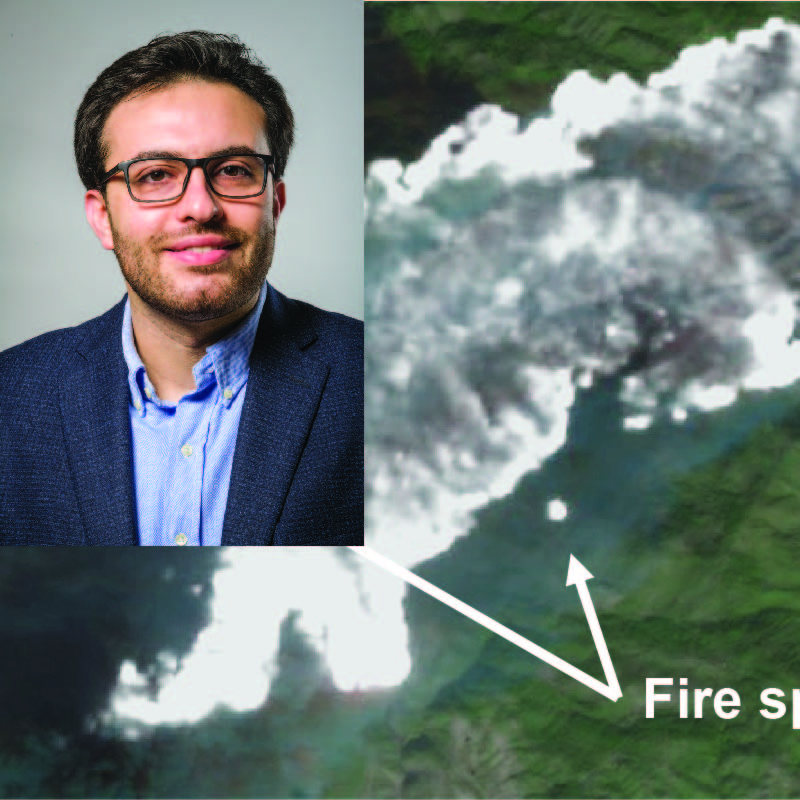News Story
UM Blazes Trail with Fire Protection Engineering Program

Photo by Eric Stocklin, Maryland Daily Record
By KAREN BUCKELEW,
Daily Record
Business Writer
Michael Connolly is fascinated with flames.
The 22-year-old Baltimore native says he always has been interested in fire, but he never realized he could make a career out of it.
That is, until he heard about the fire protection engineering program at the University of Maryland, College Park, one of very few such programs in the country, and the only one accredited as an engineering undergraduate degree.
“There’s a major where people can burn things, get paid for it and not go to jail,” Connolly remembers thinking.
Four years later, he is about to graduate with his bachelor’s degree in fire protection engineering from the A. James Clark School of Engineering on the university’s College Park campus.
And like his fellow students and the 1,000 or so undergraduates and graduates who have completed the program since it began 50 years ago, Connolly has the odds on his side.
Fire protection engineering undergrads average three to five job offers before they even leave the school, with an average annual starting salary of more than $50,000 for those positions, often consulting jobs, according to Department Chair Marino di Marzo.
The average starting salary nationwide for the profession is $55,000, according to the Society of Fire Protection Engineers, and the industry-wide mean is $91,000.
“There is this tremendous demand” from employers for fire protection engineers, di Marzo said. “We get a continuous flow of requests for our graduates.”
The department celebrated its 50th anniversary on Oct. 14 with a gala event hosting alumni.
There is more demand than ever before for fire protection engineers, who consult with architects and contractors on the construction and design of enormous buildings as well as the methods required for evacuating them in the event of an emergency, the experts said.
“Over the last number of years, there’s been increasing attention paid to safety in our society in general,” said James A. Milke, associate chair of the department of fire protection engineering at the Clark School and an associate professor.
For example, several years ago, air bags were a luxury in automobiles now they are expected.
“The interest in fire safety has similarly increased in the public’s mindset,” Milke added. “Certainly, 9/11 helped to reinforce that.”
Still, only the Clark School of Engineering offers a fire protection bachelor’s degree, accredited as an engineering degree under the Accreditation Board for Engineering and Technology, which certifies American engineering and tech programs.
Other undergrad programs, including one at Oklahoma State University, are accredited as technology programs.
And Worchester Polytechnic Institute in Massachusetts offers both master’s and doctoral degrees in the field. To earn a doctorate from the Clark School program, students work in the mechanical engineering department with an emphasis on fire protection.
The few programs in the U.S. are struggling to produce enough graduates to fill the need. Demand is so great that graduates with only their bachelor’s are valued almost as much as master’s or doctoral students.
“There’s a need now, and it cannot but grow,” di Marzo explained. “I think it’s going to be a big problem in the future, not for us, but nationally. Someone has to step up to the plate.”
The department began in 1956 after years of discussions between the university leadership and the Maryland State Firemen’s Association, which had been stressing with educators the importance of fire engineering, according to the school.
The department’s first class began with seven students in the fall of 1957. In January 1962 the first student graduated, followed by four more in June of that year.
In 1989 the program began offering master’s degrees in fire protection engineering.
And in 2002, the school initiated its distance learning program, an Internet-based graduate program designed for professionals working toward their graduate degrees.
Di Marzo’s department still is growing. With eight full-time faculty members currently, the chairman plans to add another next year, in part to deal with the recent leap in external funding for research projects from $400,000 in government and private funds in Fiscal Year 2002 to $2.6 million this year.
“Research,” di Marzo noted, “has gone through the roof.”
So has public interest in his field.
Fire protection used to be a less technical profession, the chair explained, based on prescriptive codes that dictated things such as how many sprinklers were required in rooms of a certain size, and how many inches apart those sprinklers should be from one another the type of information better suited to a sprinkler technician than an engineer.
But the winds have shifted, particularly since Sept. 11, di Marzo said. Architects and designers and construction contractors are looking more toward what he called “performance-based design.”
That means designing and building staircases to funnel people out most effectively during an evacuation, and considering how to construct walls so they will best withstand flames.
Many of the department’s bachelor’s and master’s graduates go to consulting firms that provide those services for other companies. A few large architecture firms keep their own fire protection engineers on staff.
And then there are the government regulators required to make sure new buildings adhere to new safety requirements fire protection engineers fill those positions as well.
The engineers also work in the development of new products next-generation sprinklers and smoke detectors, upholstery fabrics that don’t burn easily, fire-proof mattresses.
And when a fire gets out of control and causes severe damage, someone needs to investigate the blaze; fire protection engineers are becoming common in that area as well.
“The whole market is shifting toward highly trained people,” said di Marzo.
But who is drawn to these programs, where playing with fire becomes a profession?
People like Connolly and Milke Connolly, whose uncle was a Baltimore City firefighter, and Milke, himself a volunteer firefighter.
“There are many [students] that have come to us through some sort of firefighting connection personal involvement, or a close neighbor or Uncle Joe” is a firefighter, Milke explained.
But if students don’t choose to attend the Clark School or the Worchester Polytechnic Institute, they can cobble together engineering degrees with fire protection concentrations, as Milke himself did before the University of Maryland began offering graduate programs in the subject.
The Clark School program has benefited from the presence on its College Park campus of the Maryland Fire and Rescue Institute, the university’s 70-year-old program to provide training to members of government and industry on safety and emergency services.
And the department is getting a brand-new space, an entire floor on the campus’s J.M. Patterson Building that will provide about 1.5 times its current square-footage. The offices will be ready for move-in by the end of this year, di Marzo said, but the new, state-of-the-art lab space will take another year to outfit.
Milke who once set out to be a physicist said he is happy to be a part of what is going on within the industry.
“It is an exciting field,” he said, “a growing field that still is developing.”
And Connolly is looking forward to graduating next spring, glad, he says, he went with his instincts about joining the department four years ago, though he knew little about the profession.
“I had different expectations coming in,” Connolly said, “but I feel like I know a little more about what I’m going to do the rest of my life.”
And unlike many of his fellow undergrads, the fire protection engineering major isn’t harboring much worry about his future he’s just waiting for those job offers to flow in.
“I’m not concerned at all,” he said.
Published October 16, 2006









